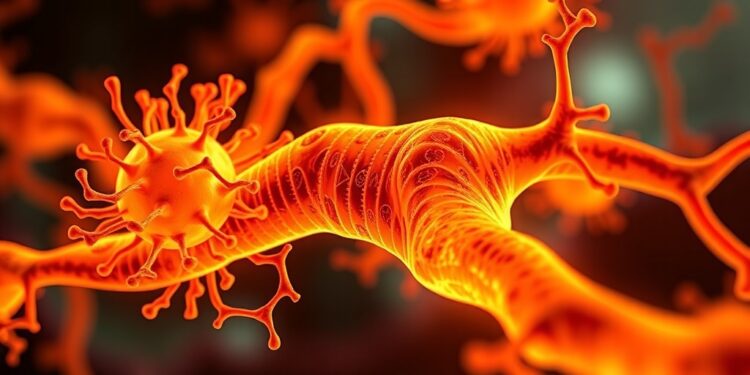
Researchers at Columbia University’s Vagelos College of Physicians and Surgeons have made a groundbreaking advancement in understanding cellular biology using a cutting-edge artificial intelligence (AI) model that predicts gene activity across various human cell types. This advancement, detailed in the latest issue of Nature, marks a pivotal shift towards making biology a more predictive science, which could significantly enhance our grasp of diseases including cancer and genetic disorders. The innovative approach represents a departure from conventional methodologies that largely describe biological phenomena without the capacity to anticipate cellular responses to genetic alterations or environmental shifts.
Raul Rabadan, a professor of systems biology and the senior author of this study, highlights that the newly developed predictive computational model can swiftly and accurately unveil biological processes. This capability enables researchers to conduct extensive computational investigations that can enhance and direct traditional experimental methods in biology. The promise of this system lies not only in its ability to analyze vast datasets but also in its potential to make real-time predictions about cellular behavior based on current genetic information.
Traditional biological research approaches often rely on established experimental designs, providing insight into cellular functions and responses to various stimuli. However, these methods fall short in predicting how cells will behave when faced with alterations, such as oncogenic mutations. Rabadan emphasizes the transformative nature of being able to foresee cellular activities, stating that this could radically enhance our understanding of the fundamental biological principles at play, changing the narrative from observation to prediction.
The arrival of this AI system aligns with a broader trend in biological sciences, where an overwhelming influx of data and advanced computational techniques are starting to reshape our understanding of life at the cellular level. The 2024 Nobel Prize in Chemistry underscored this shift by recognizing the contributions of researchers who employed AI to predict protein structures. However, predicting gene activities—impacting how proteins function within cells—has proven to be a more challenging endeavor, until now.
In their pioneering study, Rabadan and his team sought to leverage AI’s capabilities to predict gene activity within specific cell types. The focus on gene expression is crucial, as it provides insights into cellular identity and functional behavior. Traditional models have often been limited to specific types of cells, typically cancerous cell lines that may not accurately mimic the conditions of normal human cells. In contrast, graduate student Xi Fu approached this challenge by training a machine learning model using gene expression data drawn from millions of normal human cells.
By incorporating genome sequences along with the information highlighting which genomic regions were accessible and expressed, Fu’s model bore resemblance to popular AI systems like ChatGPT. Such systems deduce the underlying logic of natural language through extensive datasets, allowing them to generate coherent responses. Rabadan explains that their approach follows suit—by pinpointing the ‘grammar’ of cellular behavior across numerous cellular states, the model can then predict how cells will function in both normal and diseased conditions.
The culmination of this research involved collaboration with a diverse team, including co-first authors Alejandro Buendia and Shentong Mo, who contributed significantly to both the training and validation of the AI model. After analyzing gene expression data from over 1.3 million human cells, the AI system displayed remarkable accuracy in predicting gene expression in previously unencountered cell types. The consistency of these predictions with experimental data bodes well for the model’s reliability in real-world applications.
The model’s prowess was further exemplified when researchers tasked it with uncovering the intricate biological mechanisms underlying a specific pediatric leukemia. By analyzing mutations linked to this disease, the AI proposed that these genetic alterations interfere with the interactions between vital transcription factors responsible for dictating the fate of leukemic cells. Remarkably, subsequent laboratory experiments substantiated the model’s predictions, unlocking new avenues for targeted interventions and precise treatment strategies.
Furthermore, the implications of this model extend to the enigmatic realms of the genome often referred to as the “dark matter.” This term encapsulates areas of the genome that do not code for proteins and have long remained elusive in terms of their functional importance. Rabadan points out that a significant proportion of mutations identified in cancer patients occur in these largely unexplored regions. The AI’s ability to analyze such mutations could illuminate these dark areas, offering insights into their roles in disease progression and potentially uncovering therapeutic targets.
In light of the ongoing advancements in AI applications within biological research, Rabadan expresses enthusiasm for the emerging era defined by these innovations. By harnessing the predictive capabilities afforded by the AI model, researchers can now decipher how mutations affect cellular functions, thereby offering tangible pathways for exploring treatments across a wide array of diseases, not limited to cancer. The integration of predictive models into biological research marks a fundamental shift, setting the stage for a new era of scientific discovery.
As researchers at Columbia University and other institutions embark on deeper explorations into various cancers—from blood to brain malignancies—they are not just observing changes in cell behavior; they are actively predicting and understanding the grammar of regulation in both healthy and diseased cells. The potential for this predictive science to reshape our understanding of biological systems cannot be overstated, heralding a future where biological research is more proactive than ever before.
This study delivers profound implications for the field of genetics and medicine, empowering scientists with the tools to foresee genetic repercussions and devise innovative strategies to combat diseases rooted in genetic anomalies. With the promise of predictive models becoming integral to biological investigations, the landscape of life sciences is poised for remarkable transformation.
Subject of Research: Cells
Article Title: A foundational model of transcription across human cell types
News Publication Date: 8-Jan-2025
Web References: cuimc.columbia.edu
References: 10.1038/s41586-024-08391-z
Image Credits: N/A
Keywords
Gene prediction, Computer modeling, Genetics, AI in biology, Predictive models, Cancer research





